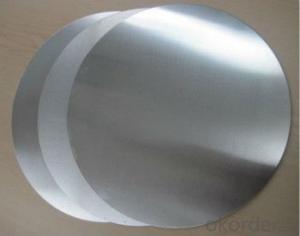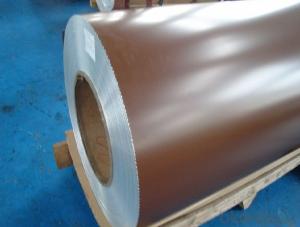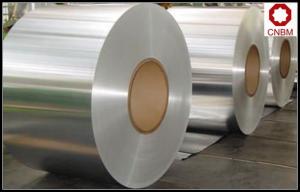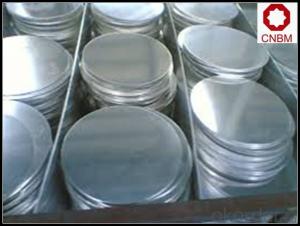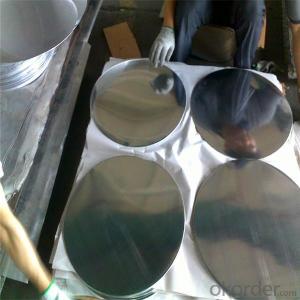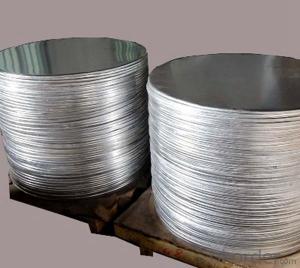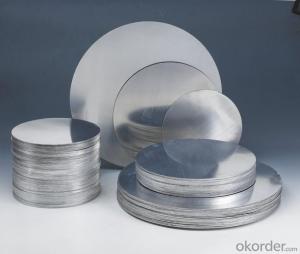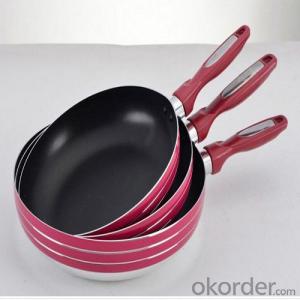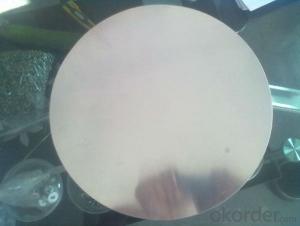Aluminum Coils Canada CC Circle for Aluminium Cookware Application
- Loading Port:
- Shanghai
- Payment Terms:
- TT OR LC
- Min Order Qty:
- 5 m.t.
- Supply Capability:
- 2000 m.t./month
OKorder Service Pledge
OKorder Financial Service
You Might Also Like
1. Structure of CC Aluminium in Coil Form for making Aluminium Circle Description
CC Aluminium in Coil Form for making Aluminium Circle is one semi-finished aluminium material. This coil can be rolled down to aluminium coil,sheet,circle ect. The alloy AA1050 is widly used in building, industry ect. Its weight is much lower than steel. So many customers choosed aluminium material instead of steel. Aluminium circle is widely used for kitchen wares including fried pans, non-sticky pans, cooking pots, hard anodize cook ware, pressure cooker and house hold utensils etc.
2. Specification of CC Aluminium in Coil Form for making Aluminium Circle
Aluminum Coil/Sheet | |
Main Specification | |
Alloy | AA1xxx (AA1050, AA1060, AA1070, AA1100 etc.) |
AA3xxx (AA3003, AA3004, AA3005, AA3105 etc.) | |
AA5xxx, AA6XXX (AA5052,AA5083, AA5754, AA6061, AA6062 etc.) | |
AA8xxx(AA8011, AA8006 etc.) | |
Temper | H14,H16, H18, H22, H24, H26, H32,O/F, T4, T6, T651 |
Thickmess | 0.01mm-100mm |
Width | 30mm-1700mm |
Standard | GB/T 3880-2006/ASTM |
Special specification is available on customer's requirement | |
3. Feature of CC Aluminium in Coil Form for making Aluminium Circle
Surfact Quality :
Be free from Oil Stain, Dent, Inclusion, Scratches, Stain, Oxide Dicoloration, Breaks, Corrosion, Roll Marks, Dirt Streaks and other defect which will interfere with use,
Mechenical Property:
Chemical Composite and Mechanical Property
4. Image of Aluminium Circle
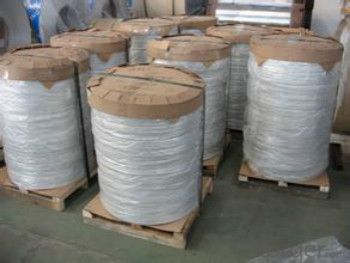
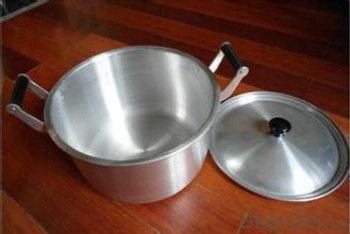
5. FAQ
1) What is the delivery time?
Depends on actual order, around 20 to 35 days
2) What is the QC system:
We have QC staff of 20 persons and advanced equipment, each production is with MTC traced from Aluminum ingot lot.
3) What market do you mainly sell to?
Australia, America, Asia, Middle East, Western Europe, Africa etc
4) Payment term?
30% T/T in advance, balance against B/L copy.
- Q: What are the proper storage methods to maintain the quality of aluminum coil for future use?
- <p>To store aluminum coil for future use, ensure it is kept in a cool, dry place away from direct sunlight and moisture. Stack the coils on flat, level surfaces with appropriate padding to prevent damage. Avoid stacking with other metals to prevent galvanic corrosion. Use clean, dry hands or gloves when handling to prevent oil and dirt from contaminating the surface. Store in a controlled environment with a relative humidity below 65% and a temperature between 32掳F to 90掳F (0掳C to 32掳C). Regularly inspect the coils for any signs of corrosion or damage.</p>
- Q: What is the role of aluminum coils in the transportation industry?
- Aluminum coils play a crucial role in the transportation industry due to their numerous advantageous properties. One of the primary uses of aluminum coils is in the manufacturing of transportation vehicles, such as cars, trucks, trains, and airplanes. Aluminum is a lightweight material, with a density significantly lower than steel, which makes it an ideal choice for enhancing fuel efficiency and reducing overall weight in transportation systems. The use of aluminum coils in transportation vehicles provides several benefits. Firstly, the lightweight nature of aluminum helps increase fuel efficiency, as vehicles require less energy to move with reduced weight. This results in lower fuel consumption, reduced greenhouse gas emissions, and cost savings for transportation companies. Moreover, aluminum coils possess excellent corrosion resistance properties, allowing transportation vehicles to withstand harsh weather conditions, such as rain, snow, and salt exposure. This durability is particularly essential for transportation vehicles that frequently operate in coastal or snowy regions. The resistance to corrosion also enhances the longevity of the vehicles, reducing maintenance costs and ensuring a longer lifespan. In addition to their weight and corrosion resistance properties, aluminum coils offer high strength-to-weight ratio, making them a reliable choice for structural components in transportation vehicles. This strength allows manufacturers to design lighter and more efficient vehicles without compromising safety or durability. Furthermore, aluminum coils contribute to the sustainability efforts of the transportation industry. Aluminum is a highly recyclable material, and the recycling process requires significantly less energy compared to its initial production. By utilizing aluminum coils in transportation vehicles, the industry can minimize its environmental impact and reduce the reliance on non-renewable resources. In conclusion, aluminum coils play a pivotal role in the transportation industry by contributing to fuel efficiency, corrosion resistance, lightweight design, structural strength, and sustainability. Their use in manufacturing transportation vehicles helps achieve cost savings, reduce emissions, enhance durability, and improve overall efficiency in the transportation sector.
- Q: What are the color options available for aluminum coils?
- The color options available for aluminum coils are typically vast and varied, ranging from standard colors like white, black, and silver to a wide array of custom colors and finishes. Some popular options include metallic, matte, gloss, and textured finishes, allowing for endless possibilities in terms of design and aesthetics.
- Q: What are the different ACP (Aluminum Composite Panel) applications for aluminum coils?
- Aluminum coils have numerous applications in the production of Aluminum Composite Panels (ACP), which is a popular building material known for its lightweight, durability, and versatility. Below are some examples of how aluminum coils are used in the ACP industry: 1. Building Cladding: ACP is widely used as cladding material for building exteriors. The aluminum coils are coated with a protective layer and bonded to a core material, usually made of polyethylene. This combination provides excellent strength, weather resistance, and insulation properties. 2. Signage and Advertising: Aluminum coils are used to create signage and advertising boards. The panels can be easily cut, bent, and formed into various designs and sizes, making them ideal for eye-catching displays and billboards. 3. Interior Decoration: ACP is frequently used for interior decoration purposes. It can be used for wall panels, ceiling panels, partitions, and decorative elements. The aluminum coils can be coated with different colors, finishes, and textures to achieve the desired aesthetic appearance. 4. Furniture Manufacturing: Aluminum coils are used in furniture production, especially for creating lightweight and durable surfaces. ACPs can be used for tabletops, cabinet doors, shelves, and other furniture components. 5. Transportation Industry: Aluminum coils find applications in the transportation industry. ACPs can be used to construct vehicle bodies, including buses, trucks, and trailers. The lightweight nature of ACPs helps reduce the overall weight of the vehicle, resulting in improved fuel efficiency. 6. Industrial Applications: ACPs are widely used in various industrial applications. They can serve as wall cladding in manufacturing facilities, cleanrooms, warehouses, and other industrial buildings. The panels provide insulation, fire resistance, and easy maintenance, making them suitable for such environments. 7. Renewable Energy Sector: Aluminum coils are used to produce solar panel frames. ACPs offer exceptional strength and corrosion resistance, making them an ideal choice for providing structural support to solar panels. In conclusion, aluminum coils are versatile materials that have a wide range of applications in various industries for the production of Aluminum Composite Panels. From building cladding to signage, interior decoration, furniture manufacturing, transportation, industrial applications, and the renewable energy sector, ACPs are extensively used.
- Q: This question asks about the environmental impact of aluminum coils, including potential effects on the ecosystem and human health.
- <p>Aluminum coils, when produced and used responsibly, have minimal environmental impact. However, improper disposal or manufacturing can lead to pollution. Aluminum production requires significant energy, contributing to greenhouse gas emissions. During manufacturing, if not managed properly, can release harmful substances into the air and water. Yet, aluminum is highly recyclable, reducing its environmental footprint over time. When disposed of improperly, aluminum can contribute to litter and leach harmful substances into the soil and water, affecting wildlife and potentially human health. Responsible recycling and manufacturing practices are crucial to mitigate these effects.</p>
- Q: What are the strength properties of aluminum coils?
- High tensile strength, excellent formability, and good resistance to corrosion are among the strength properties exhibited by aluminum coils. These coils are favored in various industries like automotive, aerospace, and construction due to their high strength-to-weight ratio. They can endure heavy loads without deforming or breaking, as well as resist fatigue. Furthermore, aluminum coils offer easy shaping and bending without compromising their structural integrity, thanks to their excellent formability. Additionally, the natural oxide layer of aluminum acts as a protective barrier against corrosion, rendering aluminum coils highly resistant to rust and other forms of degradation. In conclusion, the versatility and reliability of aluminum coils make them an ideal material for a wide range of applications.
- Q: What are the various surface finishes available for aluminum coils?
- Aluminum coils offer a variety of surface finishes to meet different needs and preferences. The options include: 1. Mill Finish: This is the most basic and natural finish achieved by passing the coil through rollers during manufacturing. It gives the aluminum a smooth, shiny appearance. 2. Anodized Finish: Anodizing is an electrochemical process that adds a protective layer to the aluminum coil's surface. It comes in various colors and provides enhanced resistance to corrosion, abrasion, and wear. Architects commonly use anodized finishes. 3. Painted Finish: Aesthetic appeal and environmental protection can be achieved by coating aluminum coils with paint. The paint comes in different colors and finishes, such as matte, glossy, or metallic. 4. Brushed Finish: By brushing the surface with abrasive materials, aluminum coils can have a textured appearance with fine lines or scratches. Brushed finishes are often used for decorative purposes. 5. Polished Finish: Buffing the surface of the aluminum coil creates a smooth, reflective finish. It gives a mirror-like appearance and is commonly used for decorative and architectural applications. 6. Embossed Finish: Embossing involves stamping or pressing a pattern or design onto the surface of the aluminum coil. This finish adds texture and depth, making it suitable for non-slip surfaces or decorative purposes. 7. Laminated Finish: Lamination involves bonding a thin layer of film or foil to the aluminum coil's surface. This finish provides additional protection against scratches, stains, or UV radiation. It is commonly used for applications that require durability and resistance. These examples highlight the range of surface finishes available for aluminum coils. The choice of finish depends on specific application requirements, desired appearance, and functional properties needed for the end product.
- Q: im melting aluminum and what should i use for metal. cans will just oxygenize( i forget the word for it sorry)
- aluminum, in general, will just oxidize if heated in air. it is not just cans that behave that way when they (alcan, alcoa) smelt aluminum industrially they keep it in a reducing environment and do not allow molten aluminum to contact air. so use any aluminum you like but prevent it from contacting air.
- Q: How are aluminum coils used in heat exchangers?
- Aluminum coils are widely used in heat exchangers due to their excellent thermal conductivity and corrosion resistance. They are typically used as the main component in the evaporator and condenser sections of the heat exchanger. The coils facilitate the transfer of heat between two fluids, allowing for efficient cooling or heating processes. The design of the coils, along with their large surface area, helps to maximize heat transfer and enhance the overall performance of the heat exchanger.
- Q: 94 f150. have the stock wheels which are weathered and dull. whats a good way to bring the shine back? some of the original coating is there ,most is gone. tried mothers aluminum wheel polish,does nothing. is it wise to use a wire wheel in a drill to get down to just the aluminum? the wheels are those with the center plastic cap with holes around the outer edge.thanks for any info
- I am not sure if you can sand them down an put a clear coat on them? I can say this is why you see older vehicles with plasti-dip coatings, to cover up the dings, curb rash and peeling clear coat, and the cost is lower than replacement. List your city and state. In my area there is wheel specialty shop that does tig welding repairs and will do a factory refinish. Look for one of those places. Or buy new rims and sell the old ones online.
Send your message to us
Aluminum Coils Canada CC Circle for Aluminium Cookware Application
- Loading Port:
- Shanghai
- Payment Terms:
- TT OR LC
- Min Order Qty:
- 5 m.t.
- Supply Capability:
- 2000 m.t./month
OKorder Service Pledge
OKorder Financial Service
Similar products
Hot products
Hot Searches
Related keywords
